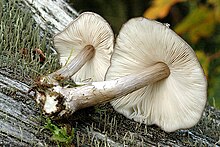| Pluteus | |
|---|---|

| |
| Pluteus cervinus | |
| Scientific classification | |
| Domain: | Eukaryota |
| Kingdom: | Fungi |
| Division: | Basidiomycota |
| Class: | Agaricomycetes |
| Order: | Agaricales |
| Family: | Pluteaceae |
| Genus: | Pluteus Fr. |
| Type species | |
| Pluteus cervinus | |
| Species | |
|
Pluteus brunneidiscus | |
| Pluteus | |
|---|---|
| Gills on hymenium | |
| Cap is flat or convex | |
| Hymenium is free | |
| Stipe is bare | |
| Spore print is pink | |
| Ecology is saprotrophic | |
| Edibility is edible or psychoactive | |
Pluteus is a large genus of fungi with over 300 species. They are wood rotting saprobes with pink spore prints and gills that are free from the stem.
The Latin word Pluteus means shed or penthouse.[1]
Characteristics of the genus[edit]
Characteristics of the Pluteus genus are:[2][3]
- These fungi grow on wood or wood remains.
- The spore powder is deep pink, soon giving a pink tint to the initially pale gills.
- The gills are free from the stipe.
- There is no volva or ring (exception: the rare recently reclassified North American species P. mammillatus, previously Chamaeota sphaerospora).[4]
- Microscopically, they often have abundant, distinctive cystidia. The spores are smooth and roughly egg-shaped.
Pluteus is separated from Volvariella due to the lack of a volva, and from Entoloma by growing on wood and by microscopic features (Entolomas have angular spores).
Naming[edit]
The name Pluteus was established in 1837 by the founding mycologist Elias Magnus Fries at a time when agaric mushrooms were first being assigned to different genera. [5]
The Latin word "pluteus" has various meanings related to military protective structures and its signification here may be that of a shield (the shape of the cap). [6] [7] [8]
Remarks on particular species[edit]
Some of these mushrooms are edible including P. petasatus and P. cervinus, though most people rate their taste and consistency as average at best.
Pluteus cervinus is the best known species in Europe and North America.
Several species of this genus bruise blue and contain psilocybin[9] including Pluteus brunneidiscus,[10] Pluteus salicinus, Pluteus cyanopus, Pluteus glaucus, Pluteus nigroviridis, Pluteus phaeocyanopus and Pluteus villosus.[11]
See also[edit]
References[edit]
- ^ The mushroom hunter's field guide By Alexander Hanchett Smith, Nancy S. Weber
- ^ Meinhard Moser, translated by Simon Plant: Keys to Agarics and Boleti (Roger Phillips 1983) ISBN 0-9508486-0-3
- ^ Courtecuisse, R. & Duhem, B. (1994) "Guide des champignons de France et d'Europe" Delachaux et Niestlé ISBN 2-603-00953-2, also available in English
- ^ A. M. Minnis, W. J. Sundberg et al., Annulate Pluteus species, a study of the genus Chamaeota in the United States", MYCOTAXON Vol. 96 pp. 31-39, April-June 2006
- ^ "Pluteus page". Species Fungorum. Royal Botanic Gardens Kew. Retrieved 2021-01-28.
- ^ Lewis, Charlton T.; Short, Charles. "pluteus". A Latin Dictionary. Perseus Digital Library. Retrieved 2021-01-28.
- ^ Etymology section of ""Pluteus atromarginatus (Singer) Kuhner - Blackedged Shield"". First Nature. Retrieved 2021-01-28.
- ^ The mushroom hunter's field guide By Alexander Hanchett Smith, Nancy S. Weber
- ^ G. Guzmán, J. W. Allen & J. Gartz, "A Worldwide Geographical Distribution of the Neurotropic Fungi, an Analysis and Discussion"
- ^ Justo, A. & M.L. Castro. (2007). "Observations in Pluteus section Pluteus in Spain: Two new records for Europe". Mycotaxon 102: 209–220.
- ^ Fungifama site
Further reading[edit]
- M. Kuo "The Genus Pluteus"
- Gastón Guzmán; John W. Allen; Jochen Gartz (1998). "A worldwide geographical distribution of the neurotropic fungi, an analysis and discussion" (PDF). Annali del Museo Civico di Rovereto (14): 189–280. (on Fondazione Museo Civico di Rovereto)
 Media related to Pluteus at Wikimedia Commons
Media related to Pluteus at Wikimedia Commons